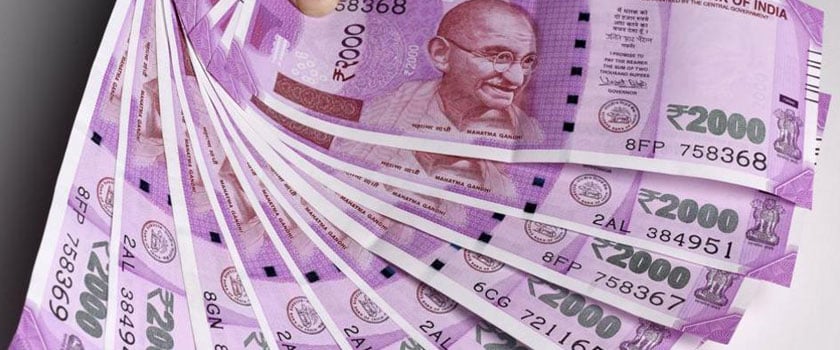Published
11 months agoon

The Reserve Bank of India (RBI) on May 19, 2023 announced a significant step to withdraw the Rs 2,000 denomination banknotes from circulation. The central bank asked all to deposit the Rs 2,000 banknotes into their accounts or exchange them for banknotes of other denominations at any bank branch by September 30, 2023.
Starting from May 23, 2023, the RBI has announced the availability of an exchange facility for Rs 2,000 currency notes. It’s important to note that the existing Rs 2,000 denomination banknotes will remain valid as legal tender. The central bank further advised banks to stop issuing Rs 2,000 denomination banknotes with immediate effect.
In order to ensure operational convenience and to avoid disruption of regular activities of bank branches, exchange of Rs 2,000 banknotes into banknotes of other denominations can be made up to a limit of Rs 20,000 at a time at any bank May 23, 2023 onwards.
The central bank said that to complete the exercise in a time-bound manner and to provide adequate time to the members of public, all banks shall provide deposit and/or exchange facility for Rs 2,000 banknotes until September 30, 2023. Separate guidelines have also been issued to the banks.
The legal tender will continue from October 1, 2023. However, it is encouraged for everybody to exchange within the given time period. “This is a similar exercise we did in 2013-2014,” sources added.
“To complete the exercise in a time-bound manner and to provide adequate time for the members of the public, all banks shall provide deposit and/or exchange facilities for Rs 2,000 banknotes until September 30, 2023,” an RBI circular read.
The circular further added, “The Rs 2,000 denomination banknote was introduced in November 2016 under Section 24(1) of RBI Act, 1934, primarily to meet the currency requirement of the economy in an expeditious manner after the withdrawal of legal tender status of all Rs 500 and Rs 1000 banknotes in circulation at that time. The objective of introducing Rs 2,000 banknotes was met once banknotes in other denominations became available in adequate quantities. Therefore, printing of Rs 2,000 banknotes was stopped in 2018-19.”
The RBI also pointed out that this denomination is not commonly used for transactions and further, the stock of banknotes in other denominations continues to be adequate to meet the currency requirement of the public.
“In view of the above, and in pursuance of the ‘Clean Note Policy’ of the Reserve Bank of India, it has been decided to withdraw the Rs 2,000 denomination banknotes from circulation,” the RBI said, adding: “The banknotes in Rs 2,000 denomination will continue to be legal tender.”
The Clean Note Policy

The Rs 2,000 denomination banknote was introduced in November 2016 under Section 24(1) of RBI Act, 1934, primarily to meet the currency requirement of the economy in an expeditious manner after the demonetization of Rs 500 and Rs 1000 banknotes in circulation at that time. However, considering the fulfillment of their objective, the printing of Rs 2,000 banknotes had already been discontinued in 2018-19. Additionally, the usage of Rs 2,000 banknotes in daily transactions has been relatively limited, as observed by the RBI.
The RBI announced the withdrawal of Rs 2,000 notes from circulation, citing the “Clean Note Policy” as the reason behind this decision. As per Section 27 of the RBI Act of 1934, the Policy is a measure taken by the central bank to ensure that the public has access to high-quality banknotes. Its objective is to preserve the integrity of the Indian currency by removing damaged, counterfeit, or soiled notes from circulation.
On October 1, 2018, this Policy was introduced to enhance the security of digital payments.
As part of it, banks and financial institutions have the responsibility to remove unfit or damaged currency notes from circulation and replace them with new ones. The RBI regularly monitors the quality of currency notes and establishes standards for their acceptability. In December 2013, the RBI issued a statement under the aegis of this policy, urging banks to exchange soiled notes, even from non-customers, and provide the public with only clean and good-quality notes.
Declining Circulation of Rs 2,000 banknotes
The circulation of Rs 2,000 banknotes has witnessed a decline over time. Around 89% of these banknotes were issued before March 2017 and have now reached their estimated lifespan of 4-5 years. As a result, the total value of Rs 2,000 banknotes in circulation has decreased from Rs 6.73 lakh crore at its peak on March 31, 2018 (37.3% of Notes in Circulation), to Rs 3.62 lakh crore.
Currently, Rs 2,000 banknotes constitute only 10.8% of the total notes in circulation as of March 31, 2023. This reduction in circulation, coupled with limited usage, has played a significant role in the decision to withdraw the Rs 2,000 banknotes.
Accordingly, members of the public may deposit Rs 2,000 banknotes into their bank accounts and/or exchange them into banknotes of other denominations at any bank branch. Deposits into bank accounts can be made in the usual manner, that is, without restrictions and subject to extant instructions and other applicable statutory provisions.
Indian Government’s Crackdown on Social Media: A Threat to Free Speech


The Simpsons did it again! This time foreseeing Apple’s latest technological innovation – The Apple Vision Pro


Dilip Venkatraman was promoted to SVP and business head for Media and Entertainment at Tech Mahindra


Swati Bhattacharya steps down as FCB India CCO


Lodha Ventures onboards Mahesh Shah as President of Corporate Communications


Nippon India Mutual Fund names Kaiyomurz Daver as Chief Marketing Officer

